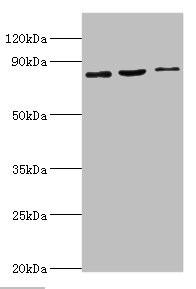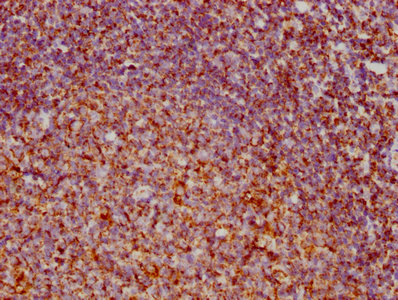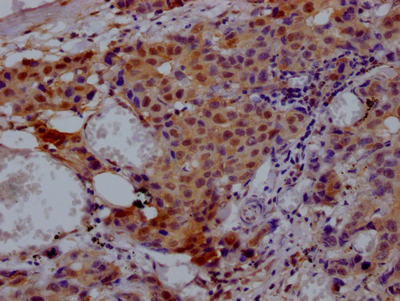SATB1 Antibody
-
货号:CSB-PA020719DSR1HU
-
规格:¥440
-
促销:
-
图片:
-
其他:
产品详情
-
产品名称:Rabbit anti-Homo sapiens (Human) SATB1 Polyclonal antibody
-
Uniprot No.:Q01826
-
基因名:SATB1
-
别名:DNA binding protein SATB1 antibody; DNA-binding protein SATB1 antibody; SATB homeobox 1 antibody; SATB1 antibody; SATB1_HUMAN antibody; Special AT rich sequence binding protein 1 (binds to nuclear matrix/scaffold associating DNA) antibody; Special AT rich sequence binding protein 1 antibody; Special AT-rich sequence-binding protein 1 antibody
-
宿主:Rabbit
-
反应种属:Human, Mouse
-
免疫原:Recombinant Human DNA-binding protein SATB1 protein (484-763AA)
-
免疫原种属:Homo sapiens (Human)
-
标记方式:Non-conjugated
-
克隆类型:Polyclonal
-
抗体亚型:IgG
-
纯化方式:Antigen Affinity Purified
-
浓度:It differs from different batches. Please contact us to confirm it.
-
保存缓冲液:PBS with 0.02% sodium azide, 50% glycerol, pH7.3.
-
产品提供形式:Liquid
-
应用范围:ELISA, WB
-
推荐稀释比:
Application Recommended Dilution WB 1:500-1:2000 -
Protocols:
-
储存条件:Upon receipt, store at -20°C or -80°C. Avoid repeated freeze.
-
货期:Basically, we can dispatch the products out in 1-3 working days after receiving your orders. Delivery time maybe differs from different purchasing way or location, please kindly consult your local distributors for specific delivery time.
相关产品
靶点详情
-
功能:Crucial silencing factor contributing to the initiation of X inactivation mediated by Xist RNA that occurs during embryogenesis and in lymphoma. Binds to DNA at special AT-rich sequences, the consensus SATB1-binding sequence (CSBS), at nuclear matrix- or scaffold-associated regions. Thought to recognize the sugar-phosphate structure of double-stranded DNA. Transcriptional repressor controlling nuclear and viral gene expression in a phosphorylated and acetylated status-dependent manner, by binding to matrix attachment regions (MARs) of DNA and inducing a local chromatin-loop remodeling. Acts as a docking site for several chromatin remodeling enzymes (e.g. PML at the MHC-I locus) and also by recruiting corepressors (HDACs) or coactivators (HATs) directly to promoters and enhancers. Modulates genes that are essential in the maturation of the immune T-cell CD8SP from thymocytes. Required for the switching of fetal globin species, and beta- and gamma-globin genes regulation during erythroid differentiation. Plays a role in chromatin organization and nuclear architecture during apoptosis. Interacts with the unique region (UR) of cytomegalovirus (CMV). Alu-like motifs and SATB1-binding sites provide a unique chromatin context which seems preferentially targeted by the HIV-1 integration machinery. Moreover, HIV-1 Tat may overcome SATB1-mediated repression of IL2 and IL2RA (interleukin) in T-cells by binding to the same domain than HDAC1. Delineates specific epigenetic modifications at target gene loci, directly up-regulating metastasis-associated genes while down-regulating tumor-suppressor genes. Reprograms chromatin organization and the transcription profiles of breast tumors to promote growth and metastasis. Promotes neuronal differentiation of neural stem/progenitor cells in the adult subventricular zone, possibly by positively regulating the expression of NEUROD1.
-
基因功能参考文献:
- SATB1 may reprogram energy metabolism in ovarian cancer by regulating lactate dehydrogenase and MCT1 levels to promote metastasis. PMID: 30132561
- Studies indicate Special AT-rich Sequence Binding Protein 1 (SATB1) to affect proliferation, cell cycle, apoptosis, cell morphology / cell polarity, EMT and multidrug-resistance as well as tumor formation, growth, invasion and metastasis [Review]. PMID: 29306014
- Study results in bladder cancer are consistent with the conflicting data reported in other cancers, and that SATB1 might have different roles in cancer dependent on genetic background and stage of the cancer. The role of SATB1 is dependent on multiple factors, its use as a biomarker limited and as a therapeutic target likely highly variable among patients. PMID: 29079132
- The aim of this study was to investigate the expression of p16 and SATB1 proteins in regard to expression of the Ki-67 antigen and available clinicopathological data (i.a. receptor status, staging and grading PMID: 29936452
- HBx upregulated hepatic SATB1. PMID: 27883059
- Invasion and metastasis of GIN in Chinese patients correlates with SATB1 overexpression in tumor tissues, most profoundly in gastric cancer. PMID: 28636989
- High SATB1 expression is associated with Immunosuppressive Function of Regulatory T Cells in Chronic Hepatitis B. PMID: 28801365
- SATB2 can induce dedifferentiation by inducing stemness and may have a role in pancreatic carcinogenesis PMID: 27472393
- High SATB1 expression was associated with a better overall survival of patients with non-small cell lung carcinoma.ATB1 level correlates with Ki-67 expression in non-small cell lung carcinoma. PMID: 29374696
- These data implied that SATB1 might regulate gene expression through its different oligomerization state. PMID: 28205095
- High SATB1 expression is associated with glioblastoma. PMID: 28049521
- These findings suggest SATB1 may play an important role in OSCC invasiveness and metastasis. PMID: 27783844
- This paper provides evidence that SATB1 plays an oncogenic role in esophageal cancer by up-regulation of FN1 and PDGFRB. PMID: 28147311
- combination of the sequence-specific and nonspecific DNA-binding modes of SATB1 should be advantageous in a search for target loci during transcriptional regulation PMID: 27462121
- revealed more than 170 NFAT-associated proteins, half of which are involved in transcriptional regulation. Among them are many hitherto unknown interaction partners of NFATc1 and NFATc2 in T cells, such as Raptor, CHEK1, CREB1, RUNX1, SATB1, Ikaros, and Helios. PMID: 27637333
- SATB1 interacts directly with OGG1, increases its binding to 8-oxoG-containing DNA, promotes Schiff base formation, and stimulates its glycosylase and apyrimidinic/apurinic lyase enzymatic activities. PMID: 27590341
- High SATB1 expression in was detected in 48.3% of esophageal squamous cell carcinoma and 7.8% of normal esophagus tissues. PMID: 25951709
- Silencing of special AT-rich sequence binding protein 1 inhibited the proliferation of KYSE450 and EC9706 cells which have a relatively high level of special AT-rich sequence binding protein 1, and the ability of migration and invasion of KYSE450 and EC9706 cells was distinctly suppressed. PMID: 28345457
- Results suggest that SATB1 is activated to bind to chromatin at S/MARs after exposure to Abeta 1-42, resulting in alternative utilization and movement of 82-kDa ChAT to these regions demonstrating that both proteins play critical roles in the response of neural cells to acute Abeta-exposure. PMID: 27052102
- Our results highlight the significance of SATB1 in intrahepatic cholangiocarcinoma PMID: 26563145
- SATB1 expression was decreased in ATL cells compared with normal controls. Knockdown of SATB1 expression significantly enhanced invasion of Jurkat cell in vitro. SATB1 knockdown enhanced beta-catenin nuclear accumulation and transcriptional activity and thus may increase the invasiveness of Jurkat cells through the activation of Wnt/beta-catenin signaling pathway in vitro. PMID: 26678884
- SATB1 binds to the upstream region of UCA1 that its promoter activity increases with SATB1 depletion and SATB1 repressed the expression of oncogenic UCA1 suppressing growth and survival. PMID: 27697109
- Decreased expression of SATB1 in ccRCC may result from over-expressed miR-21-5p. Our data suggest that SATB1 may have a potential value as a prognostic marker in ccRCC. PMID: 27107063
- overexpression of SATB1 was an independent poor prognostic factor in stage I-III, especially in stage II colorectal cancer (CRC). SATB1 may play an important role in LNM of CRC. SATB1 may be a biomarker of LNM and of recurrence after surgery for CRC PMID: 27466515
- Results suggested that high expression of SATB1 is significantly correlated with poor differentiation of CRC. SATB1 might promote the epithelial-mesenchymal transition by increasing the aberrant expression of beta-catenin. PMID: 26810818
- Logistic regression revealed that four variants in NR3C1 and SATB1 were significantly associated with lung cancer risk after false discovery rate (FDR) correction [For NR3C1, rs9324921: odds ratio (OR)=1.23, P for FDR=0.029; rs12521436: OR=0.85, P for FDR=0.040; rs4912913: OR=1.17, P for FDR=0.040; For SATB1, rs6808523: OR=1.33, P for FDR=0.040]. PMID: 27179949
- modulation of epithelial-mesenchymal transition by SATB1 may contribute to prostate cancer metastasis. PMID: 27044805
- Tumor-driven, unremitting expression of Satb1 in activated Zbtb46+ inflammatory dendritic cells that infiltrate ovarian tumors results in an immunosuppressive phenotype characterized by increased secretion of tumor-promoting Galectin-1 and IL-6. PMID: 26876172
- High expression of SATB1 is associated with colorectal cancer. PMID: 26701851
- radiation decreases SATB1 expression and sensitizes cancer cells to confer clinical benefit of patients, suggesting that SATB1 is predictive of response to preoperative RT and clinical outcome in rectal cancer. PMID: 26528635
- Findings indicate that high Ki67 antigen/ SATB1 protein ratio was an independent predictor of worse overall survival (OS), while Ki67 and SATB1 did not reach statistical significance as single predictors. PMID: 26512778
- SATB1 reprograms the expression of tumor growth- and metastasis-associated genes to promote tumorigenesis and functionally overlaps with Wnt signaling critical for colorectal cancer tumorigenesis. PMID: 26165840
- SATB1 as a Dual Regulator of Anti-Apoptotic BCL2 and Pro-Apoptotic NOXA Genes PMID: 26422397
- SATB1 protein expression showed an increasing trend in advancing stages of breast cancer development. PMID: 25966097
- replicative oncolytic adenovirus armed with SATB1 shRNA exhibits effective antitumor effect in human prostate cancer. Our study provides the basis for the development of ZD55-SATB1 for the treatment of prostate cancer PMID: 26084613
- Immunohistochemical expression of SATB1 and SATB2 was analysed in tissue microarrays with primary tumours and a subset of paired lymph node metastases from 175 patients operated with pancreaticoduodenectomy for periampullary adenocarcinoma. PMID: 25323550
- expression of SATB1 may increase the size of the BCSC population via the activation of the Notch signaling pathway and by increasing expression levels of Snail1 and Twist1. PMID: 25586771
- SATB1 and HER2 expression correlated with poorly differentiated breast cancer and indicated an unfavorable prognosis. PMID: 25956130
- SATB1 is overexpressed in pancreatic cancer, promoting cancer cell proliferation and invasion through the activation of MYC. PMID: 26108419
- Up-regulation of histidine-rich calcium binding protein promotes tumor metastasis in hepatocellular carcinoma and is mediated by SATB1. PMID: 25762622
- results suggest that SATB1 plays a crucial role in the progression of bladder cancer by regulating genes controlling EMT processes PMID: 25706386
- SATB1 mRNA, protein, and immunoreactivity levels did not correlate with patients' clinicopathological data and their overall survival, but the latter analysis was limited by a relatively short period of follow PMID: 25874491
- our data provide compelling evidence that miR-23a functions as a tumor suppressor in osteosarcoma, and its inhibitory effect on tumor are mediated chiefly through downregulation of SATB1. PMID: 25619478
- Expression of SATB1 promotes the growth and metastasis of colorectal cancer. PMID: 24971456
- High SATB1 expression is associated with recurrence in rectal cancer. PMID: 25496125
- Overexpression of special AT-rich sequence-binding protein 1 is associated with endometrial cancer. PMID: 25347096
- Moderate and high expression of SATB1 correlate with significantly better prognosis of cutaneous T-cell lymphoma patients. PMID: 25384658
- Data suggest that SATB1 expression is down-regulated during activation of hepatic stellate cell (as seen in liver fibrosis); up-regulation of SATB1 expression appears to reduce collagen synthesis and cell activation/proliferation/migration. PMID: 25896016
- This review will discuss the four major findings regarding SATB1/2 in colorectal cancer studies.[review] PMID: 25543122
- SATB1 is indispensable for lymphocyte differentiation and stem cell development. (Review) PMID: 24938377
显示更多
收起更多
-
亚细胞定位:Nucleus matrix. Nucleus, PML body. Note=Organized into a cage-like network anchoring loops of heterochromatin and tethering specialized DNA sequences. When sumoylated, localized in promyelocytic leukemia nuclear bodies (PML NBs).
-
蛋白家族:CUT homeobox family
-
组织特异性:Expressed predominantly in thymus.
-
数据库链接:
HGNC: 10541
OMIM: 602075
KEGG: hsa:6304
UniGene: Hs.517717
Most popular with customers
-
-
Phospho-YAP1 (S127) Recombinant Monoclonal Antibody
Applications: ELISA, WB, IHC
Species Reactivity: Human
-
-
-
-
-
VDAC1 Recombinant Monoclonal Antibody
Applications: ELISA, WB, IHC
Species Reactivity: Human, Mouse, Rat
-
VCP Recombinant Monoclonal Antibody
Applications: ELISA, WB, IHC, IF, IP
Species Reactivity: Human, Rat






















